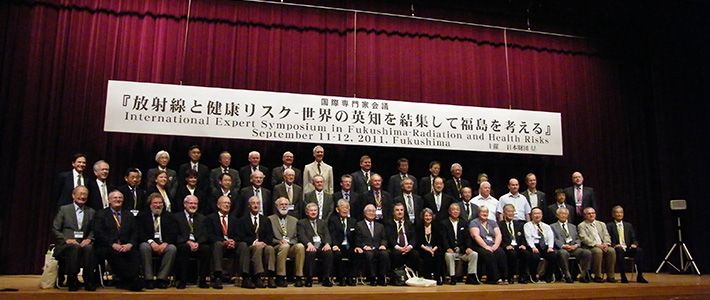
Effects of the Fukushima Daiichi Nuclear Disaster
Science Technology Society- English
- 日本語
- 简体字
- 繁體字
- Français
- Español
- العربية
- Русский
Workers continue to struggle with the disaster at the Fukushima Daiichi Nuclear Power Plant, caused by the earthquake and tsunami on March 11, 2011. Meanwhile, the residents of Fukushima Prefecture still live in fear. On September 11–12, 2011, an international expert symposium titled “Radiation and Health Risks” was held to gather specialists from Japan and abroad to identify the health effects of the radiation exposure from the disaster. Some 40 experts in radiation and nuclear power gathered at Fukushima Medical University to hold six sessions following the keynote speech by Akashi Makoto of the National Institute of Radiological Sciences, Japan.
An Open Discussion of Radiation and Health Risks
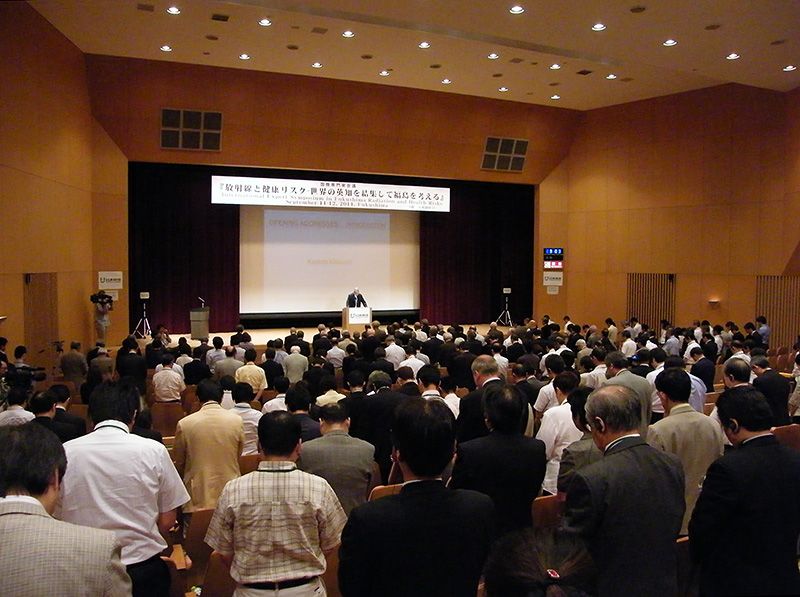 The symposium began with a moment of silence for the victims of the disaster.
The symposium began with a moment of silence for the victims of the disaster.
While similar forums have typically been closed to the public, this gathering invited media coverage and was streamed live over the Internet. Sasakawa Yōhei, chairman of the Nippon Foundation, spoke about why the symposium site had been selected: “We wanted to do what little we could to help ease the heartache and fear of the people of Fukushima.”
Before presenting some of the many highlights of the symposium discussions, let us first look back on exactly what happened in Fukushima.
At 2:46 pm on March 11, 2011, an immense earthquake calculated at magnitude 9.0 struck. Directly following the quake, a massive tsunami struck broad swaths of the Pacific coast of the Tōhoku region. At the Fukushima Daiichi Nuclear Power Plant, the reactors were shut down for safety as soon as the tremors were detected, but Reactors 1 and 4 later lost all power due to the tsunami. Having lost their cooling ability, the reactors saw rising temperatures. In the afternoon of March 12 a hydrogen explosion ripped through the structure housing Reactor 1, and two days later another blast hit Reactor 3. There were also sounds of explosions near Reactor 2 on March 15. In the structure housing Reactor 4, which was undergoing planned maintenance, it was the pool containing spent fuel rods that lost its cooling ability, leading to hydrogen explosions on March 15.
The first evacuation orders were issued to nearby residents on the night of March 11. The evacuation zone covered residents within a 3 kilometer radius of the plant, and evacuation was complete at the time of the hydrogen explosions at Reactor 1. The evacuation zone was extended to a 10 kilometer radius on the morning of March 12, and to 20 kilometers that evening. Some residents of other regions began to evacuate voluntarily, while radioactive material spreading throughout the atmosphere began to be dispersed by the wind. Decontamination of the broad area where radioactive material has fallen is underway, but results remain limited.
Contamination and Exposure in Fukushima
Session I of the symposium, “Facts of Fukushima”—cochaired by Takenoshita Seiichi of Fukushima Medical University and Maekawa Kazuhiko of the University of Tokyo—summarized the events in Fukushima from March 11 onward. The session included speeches from three presenters: Honma Toshimitsu of the Japan Atomic Energy Agency, Kamiya Kenji of Hiroshima University, and Sakai Kazuo of Japan’s National Institute of Radiological Sciences.
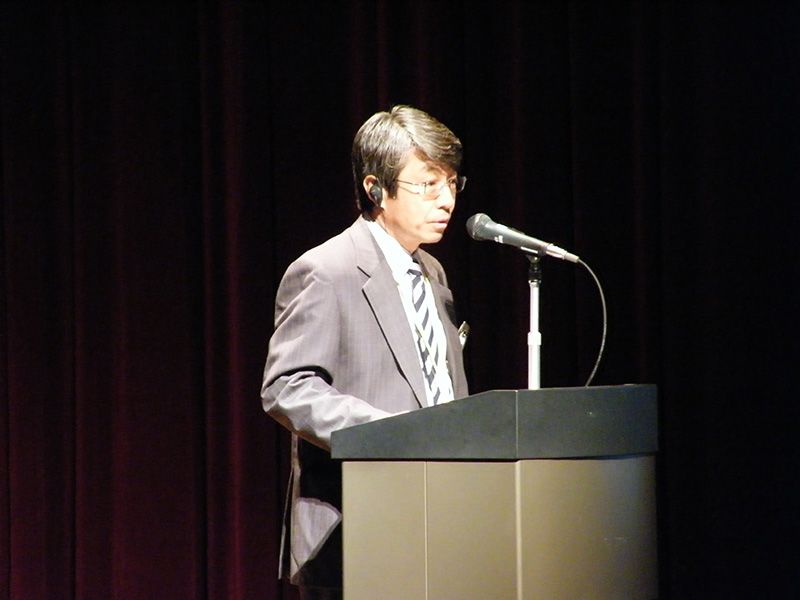 Honma Toshimitsu of the Japan Atomic Energy Agency.
Honma Toshimitsu of the Japan Atomic Energy Agency.
In his presentation, “Radioactive Contamination of the Environment and Radiation Doses to the Public,” Honma noted that the atmospheric release of radioactive material from Reactors 1–3 occurred mainly from March 12 through 22. The major types of radiation were iodine-131, with 1.6×1017 becquerels released, and cesium-137 at 1.5×1016 becquerels. These were emitted in a “radioactive plume,” a combination of radioactive gas and aerosol. In the Chernobyl nuclear disaster in 1986, a fire and meltdown occurred after the initial blast; Honma noted that the material released there differed considerably from what was seen in the Fukushima disaster.
The contamination spread throughout Fukushima on March 15–16. Radioactive material released into the atmosphere was carried northwest by the wind and then deposited in rainfall, highly contaminating the area inland from the plant. A radioactive plume also spread toward the Kantō region to the south. According to Honma, contamination spread not only to Ibaraki and Tochigi Prefectures, but also as far as Kanagawa and Shizuoka, leading to contamination of tea crops in the latter prefecture. More reports of contaminated food and water followed, forcing the Ministry of Health, Labor, and Welfare, the Fukushima prefectural government, and industry groups to issue usage and shipping restrictions.
Honma said those exposed to radiation can be divided into three groups: residents within a 3 kilometer radius of the plant, those within 10 kilometers, and those within 20 kilometers. He noted that the initial response is critical in limiting health risks, and as the evacuation of the first group was complete before the hydrogen explosions, direct exposure was limited. Consumption limits on drinking water should also have reduced internal exposure among the remaining groups, he said.
Rumors Spread on Internal Exposure
Sakai Kazuo of the National Institute of Radiological Sciences spoke about internal exposure. He emphasized the importance of a scientific discussion, noting that initial reports following the disaster mentioned only that exposure was harmful, with no discussion of dose levels.
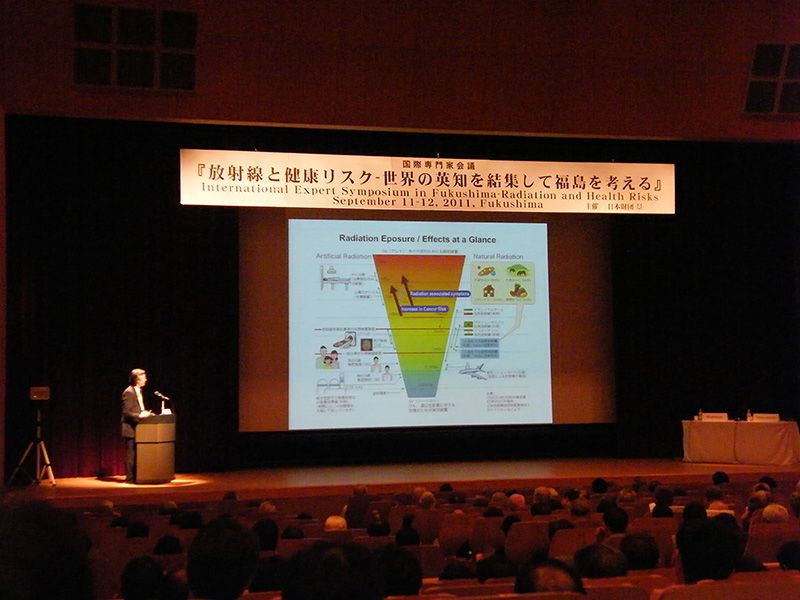 Sakai Kazuo, National Institute of Radiological Sciences.
Sakai Kazuo, National Institute of Radiological Sciences.
Sakai also indicated that although the risk is identical for external and internal exposure if radiation reaches the effective dose, there was a misunderstanding among already concerned residents that internal exposure posed a greater risk. Unfortunately, several of these rumors quickly spread. The institute even received some disturbing reports of doctors recommending abortions to women concerned about the effects of exposure on childbirth. Sakai closed by encouraging experts in both radiation research and protection to provide the general population with correct information on internal exposure.
Exposure Alone Not Necessarily Dangerous
Session II, “Low-level Irradiation and Health, Challenges Involved in Emergency Medicine,” took place in the afternoon of September 11. Researchers from US and German universities discussed the health effects and challenges in the emergency treatment of low-level radiation.
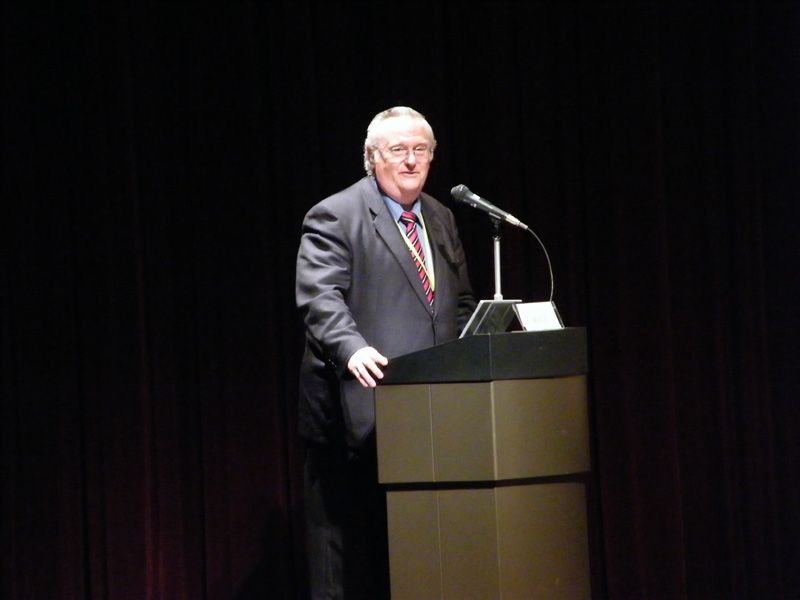 John Boice, International Epidemiology Institute.
John Boice, International Epidemiology Institute.
In his presentation, “Radiation Epidemiology: A Perspective on Fukushima,” John Boice of the International Epidemiology Institute emphasized that exposure alone does not determines the danger of radiation; dose level is another key factor. We come into contact with low-level radiation in our everyday lives from exposure to medical radiation such as x-rays, as well as from natural radiation from outer space and the earth. Based on this, annual safe exposure limits are set—for Japan the annual limit is 20 millisieverts (the sievert is a unit that quantifies the biological effects of radiation).
According to Boice, while there is no question that radiation can cause cancer, quantifying the cancer risk of low-level radiation remains an unsolved problem in radioepidemiology. He offered reassurance, though, noting that while radiation poisoning was reported after the Chernobyl disaster, no such serious incidents occurred in Fukushima. The only scientifically recognized health effect from radiation in Chernobyl was childhood thyroid cancer. But when evaluating the dose levels in Fukushima, it appears residents experienced only extremely limited internal exposure to carcinogenic ionizing radiation. Boice recommended an epidemiological study for the peace of mind and health of residents, but said estimated doses were low enough that the chance of significant health risks from chronic exposure was almost non-existent.
The Handling of Low-Level Contamination
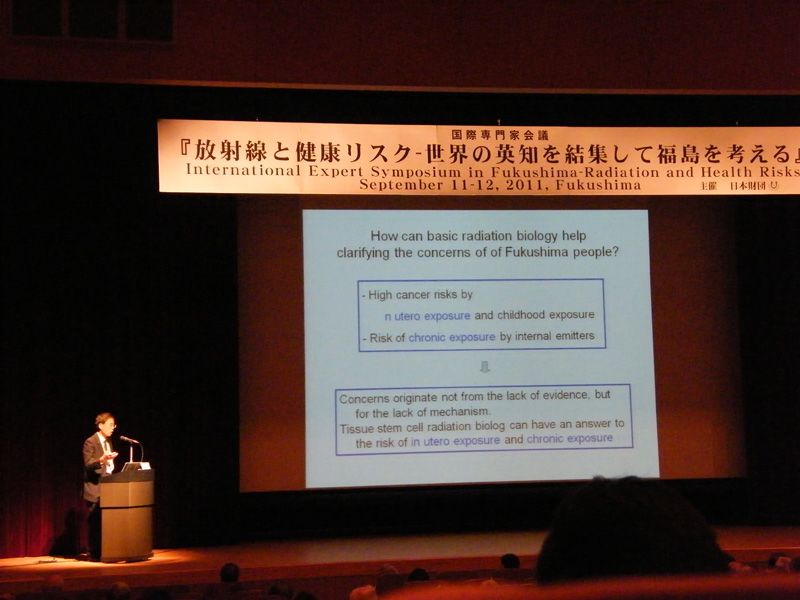 Niwa Ōtsura, Kyoto University.
Niwa Ōtsura, Kyoto University.
Session III was split into two halves. In Session IIIa, “Dose, Dosimetry, and Dose Estimations of Contaminated Areas,” Bruce Napier of the Pacific Northwest National Laboratory in the United States spoke about the processing of radioactive waste. Highly radioactive waste requires careful processing, and while dose levels for low-level contamination are correspondingly low, the volume of waste can be enormous. The handling of low-level waste requires public agreement, a difficult and long-term national discussion Napier noted had only just begun.
In Session IIIb, “Radiobiology and Radioepidemiology,” Niwa Ōtsura of Kyoto University discussed medical risks and recommended that physicians give advice based on both the patient’s individual risk factors and statistical risk.
The Psychological Effects of a Nuclear Accident
September 12, the second day of the symposium, saw the presentation of research results in Session IV, “Lessons Learned from the Chernobyl Accident,” and Session V, “Radiation Safety and Guidelines Regarding Health Risks.”
 Evelyn J. Bromet, Stony Brook University.
Evelyn J. Bromet, Stony Brook University.
Evelyn J. Bromet of Stony Brook University gave a presentation entitled “Mental Health Consequences of the Chernobyl Accident.” Following the accidents at Chernobyl and Three Mile Island, many resident suffered from depression, fear, and posttraumatic stress disorder. The causes included concerns about their own health and that of their immediate family, fear for the future, and social stigma; there is concern that similar psychological effects will be seen in Fukushima. Bromet urged that equal emphasis be placed on psychological and physical health, calling for thorough psychological care in Fukushima.
Abel Julio González of the International Commission on Radiological Protection and Yamashita Shun’ichi of Fukushima Medical University cochaired Session VI, the final discussion of the symposium. Lee Jaiki of Hanyang University spoke about the reaction to the disaster in South Korea and Wolfgang Weiss of the German Federal Office for Radiation Protection reported on the activities of the United Nations Scientific Committee on the Effects of Atomic Radiation. This UN committee plans to issue a preliminary report on the exposure and impact of the radiation from the Fukushima disaster in 2012 and a final report in 2013.
Lessons from Fukushima
Following the presentations, the participants created a report summarizing the conclusions and recommendations of the symposium. Recommendations are often issued before international symposiums, but this report was created based on the actual discussions.
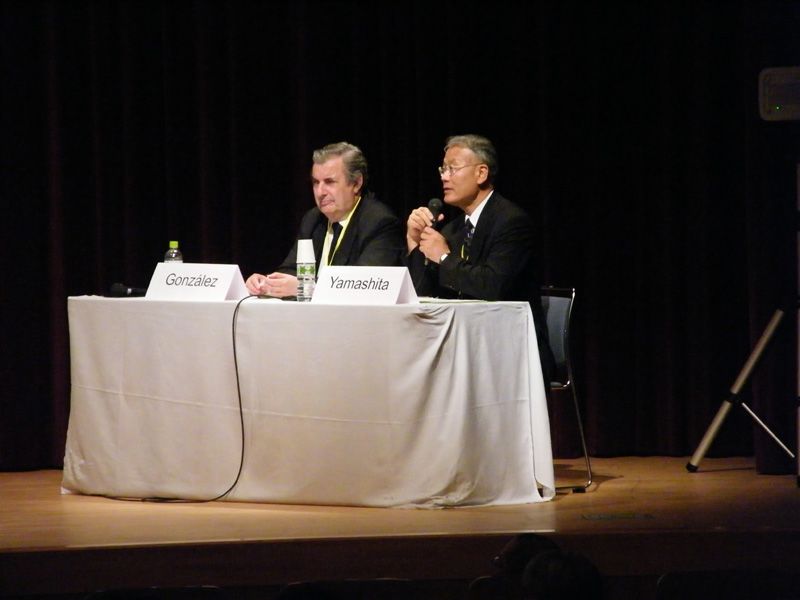 The cochairs of Session VI, Abel Julio González of the International Commission on Radiological Protection and Yamashita Shun’ichi of Fukushima Medical University.
The cochairs of Session VI, Abel Julio González of the International Commission on Radiological Protection and Yamashita Shun’ichi of Fukushima Medical University.
The first conclusion was that the evacuations of residents, calls to remain indoors to minimize exposure, and food safety regulations had been properly implemented, and that the direct health effects of exposure on residents had been limited considerably compared to Chernobyl. However, it was still a devastating disaster, and the report stated that continued monitoring of environmental radiation levels would be essential for the safety of the residents of Fukushima.
The second recommendation was for continued health monitoring. The Japanese government has already begun a study of the estimated doses from external exposure in individuals and has launched a program of thyroid ultrasound examinations for all Fukushima residents.
The final recommendation was that the Japanese government and international organizations make full use of the lessons learned from the Fukushima disaster to continue their effective, long-term cooperation.
It is our hope that the results of the symposium will contribute to a new start for all of Fukushima.
(Originally written in Japanese by Hayashi Aiko, science writer.)
International Expert Symposium in Fukushima: Radiation and Health Risks
| Sunday, September 11 | Opening SpeakersSasakawa Yōhei (Nippon Foundation, Japan) Kikuchi Shin’ichi (Fukushima Medical University, Japan) Video message by Margaret Chan (Director General, World Health Organization) Keynote Speeches“The Accident, the Workers, and the Public,” Akashi Makoto (National Institute of Radiological Sciences, Japan) “The Recommendations of the International Commission on Radiological Protection vis-à-vis the Fukushima Daiichi NPP Accident Aftermath,” Abel Julio González (International Commission on Radiological Protection) Session I: Facts of FukushimaCochairs: Takenoshita Seiichi (Fukushima Medical University, Japan) and Maekawa Kazuhiko (University of Tokyo, Japan) “Radioactive Contamination of the Environment and Radiation Doses to the Public,” Honma Toshimitsu (Japan Atomic Energy Agency) “Experience and Lessons from the Fukushima Daiichi Nuclear Disaster,” Kamiya Kenji (Hiroshima University, Japan) “Internal Exposure Caused by the Fukushima Nuclear Accident,” Sakai Kazuo (National Institute of Radiological Sciences, Japan) Session II: Low-level Irradiation and Health, Challenges Involved in Emergency MedicineCochairs: Yonekura Yoshiharu (National Institute of Radiological Sciences, Japan) and Timothy Walker (former director general, Health and Safety Executive, UK) “Medical Effects and Risks of Exposure to Ionizing Radiation,” Fred Mettler, Jr. (University of New Mexico, USA) “Epidemiological Investigations of Aircrews—an Occupational Group with Low-level Cosmic Radiation Exposure,” Hajo Zeeb (Bremen University, Germany) “Health Risks Associated with Environmental Radiation Exposures,” Scott Davis (University of Washington, USA) “Emergency Medical Preparedness for Radiological/Nuclear Incidents,” Norman Coleman (National Cancer Institute, USA) “Radiation Epidemiology: A Perspective on Fukushima,” John Boice (International Epidemiology Institute, USA) Session IIIa: Dose, Dosimetry and Dose Estimations of Contaminated AreasCochairs: Ōkubo Toshiteru (Radiation Effect Research Foundation, Japan) and Wolfgang Weiss (Federal Office for Radiation Protection, Germany) “Dosimetric Quantities in Radiological Protection and in Risk Assessments,” Hans-Georg Menzel (European Organization for Nuclear Research, Switzerland) “Estimation of Internal Radiation Dose from Both Immediate Releases and Continued Exposures to Contaminated Materials,” Bruce Napier (Pacific Northwest National Laboratory, USA) “Chernobyl Accident and Fallout from Nuclear Weapons Tests: Dosimetry, Countermeasures, and Epidemiology,” Andre Bouville (National Cancer Institute, USA) Session IIIb: Radiobiology and RadioepidemiologyCochairs: Ōkubo Toshiteru (Radiation Effect Research Foundation, Japan) and Wolfgang Weiss (Federal Office for Radiation Protection, Germany) “Implication of Stem Cells in Radiation Risks of In Utero Exposures and Low Dose Rate,” Niwa Ōtsura (Kyoto University, Japan) “Radiation and Cancer Risk in Atomic Bomb Survivors,” Kodama Kazunori (Radiation Effect Research Foundation, Japan) |
| Monday, September 12 | Session IV: Lessons Learned from the Chernobyl AccidentCochairs: Mabuchi Kiyohiko (National Cancer Institute, USA) and Arthur Schneider (University of Illinois at Chicago, USA) “Lessons of Chernobyl and Prognosis for Fukushima: Radiological Consequences,” Victor Ivanov (Medical Radiological Research Center, Ministry of Health and Social Development, Russia) “Chernobyl Experience in the Area of Retrospective Dosimetry,” Vadym Chumak (National Academy of Medical Sciences, Ukraine) “Thyroid Cancer in Ukraine Following the Accident at the Chernobyl Nuclear Power Plant (in the Framework of the Ukraine-American Thyroid Project),” Nikolai D. Tronko (Ukrainian Research Institute of Endrocrinology and Metabolism, Ukraine) “Mental Health Consequences of the Chernobyl Accident,” Evelyn J. Bromet (Stony Brook University, USA) “Chernobyl Thyroid Tissue Bank: Integrating Research on Radiation-Induced Thyroid Cancer,” G. A. Thomas (Imperial College London, UK) Session V: Radiation Safety and Guidelines Regarding Health RisksCochairs: Shima Akihiro (Institute for Environmental Sciences, Japan) and Christopher H. Clement (International Commission on Radiological Protection, Canada) “Radiation Protection Principles,” John R. Cooper (Center for Radiation, Chemical and Environmental Hazard, Health Protection Agency, UK) “Cancer models and Radiation Protection,” Richard Wakeford (University of Manchester, UK) “Protection of People Living in Long-term Contaminated Areas After a Nuclear Accident: The Recommendation of ICRP Publication 111,” Jacques Lochard (Nuclear Protection Evaluation Center, France) “Some Lessons on Radiological Protection Learned from the Accident of the Fukushima Daiichi Nuclear Power Plant,” Kai Michiaki (Ōita University, Japan) Session VI: Discussion and RecommendationsCochairs: Abel Julio González (International Commission on Radiological Protection) and Yamashita Shun’ichi (Fukushima Medical University, Japan) “Public Reaction in Korea upon the Fukushima Accident and Its Implications,” Lee Jaiki (Hanyang University, South Korea) “Preparing a Scientific Report to the General Assembly on Exposures Due to the Nuclear Accident Following the Great East Japan Earthquake and Tsunami: The Current Status of UNSCEAR Activities,” Wolfgang Weiss (Federal Office for Radiation Protection, Germany) “WHO’s Public Health Agenda in Response to the Fukushima Daiichi Nuclear Accident,” Emilie van Deventer (World Health Organization), Igor Gusev (Intenational Atomic Energy Agency), and Jan Wondergrem (Intenational Atomic Energy Agency) Closing of the SymposiumSpeakers: Kiikuni Kenzō (Sasakawa Memorial Health Foundation, Japan) and David L. Heymann (Chatham House Centre on Global Health Security, UK) |
nuclear accident Tohoku earthquake Fukushima Fukushima Daiichi Nuclear Power Plant Radiation Health Risks Radiation Exposure Health Effects Radiation Dose Chernobyl Evacuation Consumption Limits Safety Standards